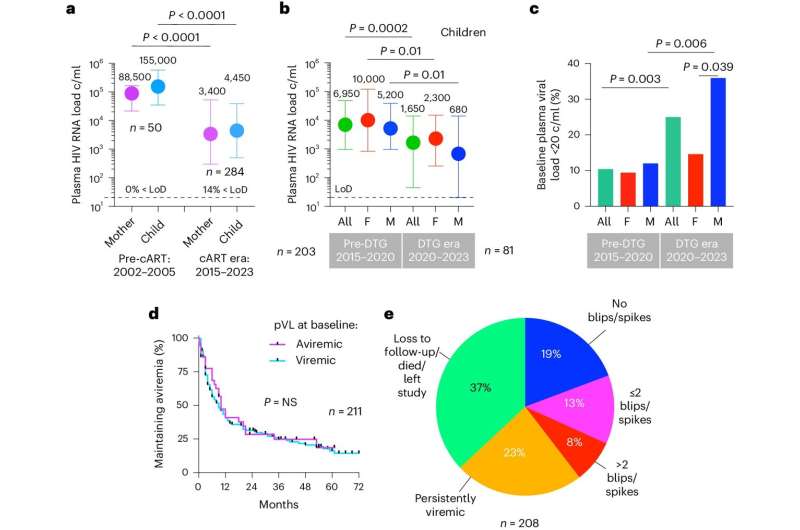This article has been reviewed according to Science X's editorial process and policies. Editors have highlighted the following attributes while ensuring the content's credibility:
fact-checked
peer-reviewed publication
proofread
Boys born with higher natural resistance to HIV, study finds

Baby girls are more likely to acquire HIV from their mothers during pregnancy or childbirth than infant boys, who are conversely more likely to achieve cure or remission, researchers say in a new study that sheds light on the gender differences in immune systems.
An estimated 1.3 million women and girls living with HIV become pregnant each year and the rate of transmission to the child during pregnancy, labor, delivery or breastfeeding—in the absence of any intervention—ranges from 15 to 45%, according to the World Health Organization.
Lead researcher Philip Goulder says the study identified some of the key mechanisms by which sustained HIV remission can be achieved—mechanisms that are relevant to children and adults alike.
Goulder and colleagues evaluated 284 infants in KwaZulu-Natal, South Africa, one of the world's highest HIV-prevalent areas, who were started at birth on a mix of HIV medicines known as combination anti-retroviral therapy (cART), after being exposed to HIV during pregnancy.
"We found that HIV transmission to male fetuses was 50% less common than to females," says Goulder, a professor of immunology at the University of Oxford's Department of Paediatrics.
"Affected males had lower levels of the virus in the blood and to date, in this study, four male infants have been identified who have achieved HIV cure/remission—i.e. maintained undetectable levels of HIV in the blood even without therapy," he told SciDev.Net.
HIV cure is categorized as "true cure" in which the virus has been eradicated totally from the body and "functional cure" or "cure/remission," in which the virus is no longer detectable in the blood even after treatment has been discontinued.
Goulder said the disparity found between male and female infants is likely due to the lower levels of activated CD4 T cells in male fetuses than in females, making it harder for the virus to establish a reservoir and providing a barrier against infection.
"If by chance a virus gets transmitted to a male, it struggles to persist because there are not enough activated CD4 T cells available to sustain the infection," he explains. "This we believe is what is happening here."
CD4 T cells are a type of white blood cell that help the body fight infections such as HIV. They are an important part of the immune system and are targeted by HIV during infection. HIV spreads more slowly with lower CD4 T cell counts.
The study published last month in the journal Nature Medicine adds to existing knowledge on HIV cure/remission and could be relevant to cure strategies not only aimed at children but those targeting all 39 million people living with HIV worldwide, according to the researchers.
"This is a breakthrough result in South Africa, where almost eight million people are living with HIV," said Nomonde Bengu, a co-author of the study at Queen Nandi Regional Hospital in KwaZulu-Natal.
The ongoing study started in 2015 and takes in 30 infants per year with 315 enrolled to date.
"This is by some way the largest cohort of its type worldwide," Bengu told SciDev.Net. "We study and follow up not only the children living with HIV but also their mothers."
Having access to the mother and child at the time of birth, when HIV may be diagnosed, has allowed the researchers to study the particular virus that was transmitted—the so-called "founder virus," says Bengu.
"This is an extremely valuable resource in understanding the mechanisms of cure/remission in children who later achieve it," she adds.
The researchers, however, say some of the male infants still have some very low-level HIV antibodies in the blood.
"The long-term implications for the children are unknown," admits Goulder. "The African child who is similar to those in our study has remained off therapy without detectable virus in the blood for 15 years, so far, and it is possible that some children may remain ART-free for life."
The findings fit exactly with what is known about adult HIV infection, according to the researchers.
They add that the mechanisms by which cure/remission can be achieved in HIV are potentially applicable across the board to all 39 million people living with HIV. The numbers of children they identified to have achieved cure/remission is small and it would be important to undertake further studies, the researchers acknowledge.
But they say it is a step forward from previous studies that identified only single children who achieved cure/remission.
"This paper adds impetus and knowledge to efforts to control HIV using immune system interventions," says Mark Cotton, emeritus professor at the Department of Paediatrics and Child Health at Stellenbosch University, South Africa, who did not participate in the research.
"The study did unfold one of the complexities—female babies more prone to acquire HIV. It also shows how children are worth studying in HIV clearance/control studies."
More information: Nomonde Bengu et al, Sustained aviremia despite anti-retroviral therapy non-adherence in male children after in utero HIV transmission, Nature Medicine (2024). DOI: 10.1038/s41591-024-03105-4





















